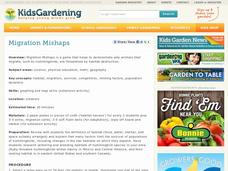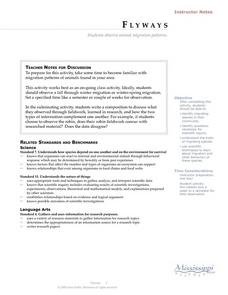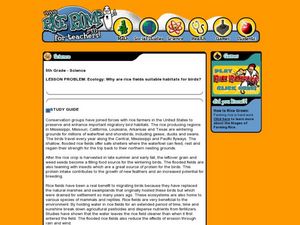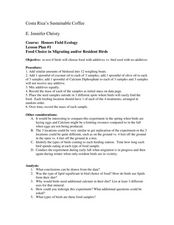National Gardening Association
Migration Mishaps
Elementary ecologists pretend to be migratory hummingbirds. They fly between wintering and nesting grounds, trying to reach a habitat haven. In a musical-chair fashion, some birds will miss out, and are removed from the game. To further...
Curated OER
Animals In Winter
Students read story Animals in Winter, and explore similarities and differences in how humans and other animals prepare for survival in winter. Students create class book that compares and illustrates different ways humans and animals...
National Wildlife Federation
Massive Migrations: Grades K-4
Bird migration is a fascinating behavior. Budding scientists experience their own migrations using the school grounds for their flight patterns. They follow a map that leads them through a migration pattern that includes stops for...
Curated OER
Birds and Coffee
Fifth graders identify the changing seasons with how they affect animal and human behavior. They explain what migration is and why many birds migrate south for the winter. They then trace the coffee sold in their neighborhood and in...
Curated OER
Birds and Migration
Students actively simulate bird migration. For this animal migration lesson, students participate in an activity that simulates the migration of birds. The teacher discusses with the class the hazards and difficulties birds face during...
Curated OER
Hawk in Flight
Students use information gathered by satellites to explore the migration of the Swainson's hawk from the western border of Minnesota to the southern portion of South America.
Curated OER
Migration Activation
Young scholars play the role of migrating birds. As a class, they simulate a migration of birds to one place and back again. They relate their habitat size and changes to their current population numbers. They discover the many dangers...
Curated OER
Plant and Animal Changes
Second graders listen as the book, "What Do Animals Do In Winter?" is read to the class. They discuss that during the winter, some animals migrate, hibernate, hide, change color, and some make changes in their bodies like growing extra...
Curated OER
In the Company of Whales
Students examine whales and how they migrate. In this whale lesson students research whales and their migration patterns.
Prince William Network
The Incredible Journey
Divide your school gym into breeding grounds and non-breeding grounds so that your zoologists can play a game simulating the seasonal migration of shorebirds. Players pick one of the included game cards and follow its directions, which...
Curated OER
Investigation 9 - Bird Study
Fourth graders examine specific bird characteristics and become more aware of the ecosystems that support each bird. They engage in bird walks, mapping the areas where they find evidence of bird activity.
Curated OER
Get Ready to Hibernate! Migrate! or Get Fat!
Students explore the different ways which animals survive the winter months, and sort animals into correct categories using a Venn diagram.
Curated OER
Animal Migratory patterns
Students use field research and traditional research to identify migrating species of birds as well as their migratory patterns. Students generate a list of questions regarding migration and a plan to research the questions. A field...
Curated OER
Why Do Some Birds Have Two Homes When We Have One?
Sixth graders study migratory birds in the temperate forest and the tropical rainforest. In this migratory birds instructional activity, 6th graders participate in different activities that explain patterns of migration, research...
Curated OER
Ecology: Why Are Rice Fields Suitable Habitats for Birds?
Fifth graders discover the uses for rice by reading about the habitats of certain birds. In this agriculture lesson, 5th graders research birds from the Gulf Coast and California and their reasons for living in rice fields....
Curated OER
Minnesota Ospreys and Migration
Students explore the route that Minnesota ospreys follow during spring and fall migration. They describe the important ecological characteristics of the places that ospreys pass through during their migration. They determine where...
Curated OER
Costa Rica's Sustainable Coffee
Students experiment to see if birds prefer to eat bird seed with additives vs. no additives. In this experimental lesson students test to see if birds notice a difference between additive and no additive food.
Curated OER
Migration Migraine
Students partipate in a demonstration in which they role play animals migrating between breeding and wintering habitats and encountering hazards at each end of the journey.
Curated OER
Heading South
Students study the concept of animal migration with the change of seasons. They discover that migration can be hazardous, and the distance migrated can be short or long.
Curated OER
Winter Survival
Students examine what animals need in order to survive. For this investigative lesson students play a "role" of an animal in winter.
Curated OER
How Animals Prepare for the Winter
Students study animals. In this hibernation instructional activity, students are read Stranger in the Woods and they discuss what various animals do in their habitat during the winter. They work as a class to create their own hibernation...
Curated OER
How Does the Rice Farmer Help Birds When They Fly South in the Winter Time?
Students draw a picture of a bird in a rice field. For this social studies lesson, students then fold a piece of paper so that there are 4 spaces. Students then draw one thing in each square that birds get from the rice field.
Curated OER
Why Do Geese Fly South For the Winter?
Fifth graders examine migration by tracing animal migration routes on a map. In this animal life lesson, 5th graders observe a map of North America and read about the migration patterns of geese. Students trace the path most...
Curated OER
Get Ready, Get Set, Hibernate
Young scholars match each body part or idea from a work bank about methods of animal adaptations for winter survival. They observe as the first one, food is covered with the whole class before completing the rest of the diagram. They...

























